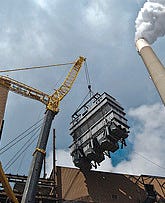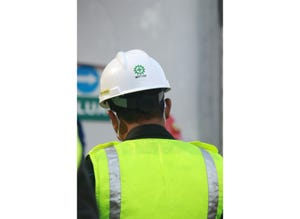Power Plant Utilizes Waste Energy to Dry Lignite
February 16, 2010
Almost a decade ago, Great River Energy (GRE) of Minneapolis initiated a project to incrementally reduce the moisture content of the lignite coal it was burning at its Coal Creek Station power plant in Underwood, ND. The process uses waste heat from the power plant as the heat source to partially dry the fuel and also make it cleaner. Pilot plant studies demonstrated the concept that led to a commercial scale Prototype dryer being designed in 2003 as part of the U.S. Department of Energy’s Clean Coal Power Initiative (CCPI). The CCPI is a cost-shared partnership between the government and industry to develop and demonstrate advanced coal-based power generation technologies on a commercial scale.
Based in part on its experience with drying coal, Heyl & Patterson Inc. was selected to assist in the design, engineering, and supply of the prototype coal dryer. The prototype drying system was to be designed to supply sufficient amounts of coal to feed one of the eight existing pulverizers. A nominal feed rate of 75 tn/hr and a maximum feed rate of 115 tn/hr were required for this purpose. The dryer was designed to dry the coal from an initial moisture of 38% to a product moisture of 29.5% using waste heat supplied to the drying system from the power plant. The heating value of the coal was increased from 6200 to 7100 Btu/lb through this reduction in moisture. A fluidized bed dryer (or fluid bed dryer) was selected for this process because of its efficient heat transfer capabilities, its compact design, and its low operating maintenance requirements. The fluid bed dryer was designed with a fully automated control system.
The prototype fluid bed dryer utilizes a combination of conduction and convection heat transfer to accomplish the evaporation. Designed to process minus ¼-in. lignite suspended in a rising flow of air, the dryer uses fluidization to provide intimate contact with the waste heat while gently handling the solids. The dryer was started up in January of 2006. Performance testing on the power plant was then conducted in March and April to determine the effect of the incremental drying of the fuel. Comparative testing was performed on the power plant operation with the drying system in operation producing dried fuel versus the drying system out of operation and the power plant burning 100% wet fuel. Tests showed that the incremental drying produces: a 23.5% reduction in moisture; a 12% increase in coal higher heating value; a 6% reduction in total volume of flue gases that must be conveyed, cooled, and treated through the power plant system; a 20% reduction in NOx emissions; a 35% reduction in SO2 emissions; and significant reductions in mercury and CO2 emissions. Over 400,000 tons of lignite coal have been processed through the prototype fluid bed dryer with no significant operating or maintenance issues.
The successful start-up and demonstration of the prototype dryer to reduce power plant emissions, increase boiler efficiency, reduce pulverizer power and maintenance, and lower power plant stack gas volumes has led to the installation of eight additional fluid bed dryers at Coal Creek Station that are capable of producing dried fuel for the entire power plant. Each of the eight drying systems will be capable of drying up to 138 tn/hr of wet coal and are physically some of the largest fluid bed systems ever built. The drying systems are currently in the start-up and testing phase of the program.
The Renneburg Div. of Heyl & Patterson Inc. provides dryers, coolers, and calciners to thermal processing customers around the world. Heyl & Patterson Inc. is based in Pittsburgh and was founded in 1887. For more information, visit www.heylpatterson.com.
 One of eight fluid bed dryers being lifted into a plant
One of eight fluid bed dryers being lifted into a plant
 One of eight fluid bed dryers being
One of eight fluid bed dryers being
You May Also Like


